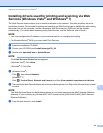
Wireless network terms and concepts
90
12
Security terms 12
Authentication and Encryption 12
Most wireless networks use some kind of security settings. These security settings define the authentication
(how the device identifies itself to the network) and encryption (how the data is encrypted as it is sent on the
network). If you do not correctly specify these options when you are configuring your Brother wireless
machine, it will not be able to connect to the wireless network. Therefore care must be taken when
configuring these options. To see which authentication and encryption methods your Brother wireless
machine supports, see Appendix A on page 97.
Authentication and Encryption methods for a personal wireless network 12
A personal wireless network is a small network, for example using your machine in a wireless network at
home, without IEEE 802.1x support.
Authentication methods 12
Open system
Wireless devices are allowed to access the network without any authentication.
Shared key
A secret pre-determined key is shared by all devices that will access the wireless network.
The Brother wireless machine uses the WEP key as the pre-determined key.
WPA-PSK/WPA2-PSK
Enables a Wi-Fi Protected Access Pre-shared key (WPA-PSK/WPA2-PSK), which enables the Brother
wireless machine to associate with access points using TKIP for WPA-PSK or AES for WPA-PSK and
WPA2-PSK (WPA-Personal).
Encryption methods 12
None
No encryption method is used.
WEP
When using WEP (Wired Equivalent Privacy), the data is transmitted and received with a secure key.
TKIP
TKIP (Temporal Key Integrity Protocol) provides per-packet key mixing, a message integrity check and
rekeying mechanism.
AES
AES (Advanced Encryption Standard) provides stronger data protection by using a symmetric-key
encryption.
NOTE
• IEEE 802.11n does not support WEP and TKIP for the encryption method.


















